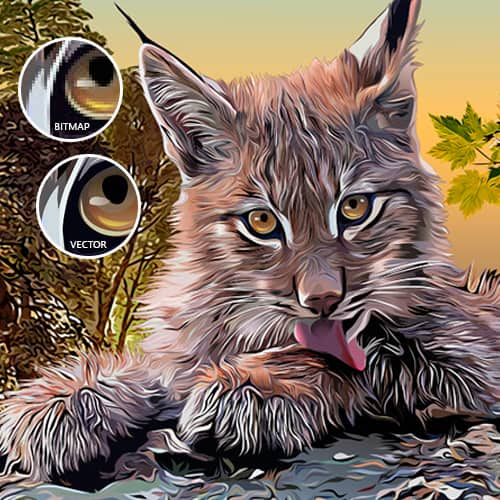CorelDRAW
Develop your edge as an artist and designer with CorelDRAW’s Guide to Vector Design. Learn the basics of vector graphics and design, and feel empowered to tackle any challenge that comes your way.


The scalable vector graphic, or SVG, might be common, but it's far from the only vector file format available. There are many options to choose from for graphic design software, like CorelDRAW or Adobe, and vector file formats, like SVGs, CDR, and AI. We’ll get into more detail on these choices below.
Some vector file formats are proprietary, belonging to a specific software developer, like the CDR, which is CorelDRAW’s native file format. Other vector formats, like the SVG, are intentionally universal, designated as the industry standard.

Even if you're not using CorelDRAW or Adobe, common proprietary formats are now widely supported across most graphic design programs. In your design career, there's a good chance that you'll encounter different vector files. Let's take a look at the main vector file types so that you can choose the right formats for your vector art projects.
The biggest difference between vector file types is in how data is stored. All vectors involve some text-based storage with mathematical equations to display the graphics properties. These equations correlate to points on a cartesian plane or mathematical coordinate system. As values in the equations are changed, mathematical rules force all values to remain in exact proportion. That's what gives vector graphics superior scalability.
Despite this fundamental similarity, there are some key differences in storing data within different file types. For example, a PDF format stores many different types of objects, including vector graphics, in one document. The catch is that PDF files only store the raw binary code in a protected format, making it challenging to isolate images from a PDF file. CorelDRAW files are compressed and stored as a Zip file. SVGs use XML to store the text-based equations for vector graphics.
In contrast, raster files are stored as pixels rather than equations, and as these pixelated images are resized, they lose clarity. Various vector file formats are superior for providing crisp, clear images with the flexibility to resize and rescale the artwork as needed.

Not all vector file formats are equal. Recognizing different file extensions and understanding when to use each file type will save you a lot of time and frustration.
Scalable vector graphics, or SVGs, are the most common vector format for web design. This universal vector file type is officially the open standard across the world wide web. These graphics feature small file sizes and all the benefits of vector graphics, making SVGs the top choice for web design and many other digital design applications.
While the SVG format is perfect for displaying vectors on the web, printing isn't this format's strongest suit. You'd be better off converting to a PDF or EPS file when you're ready to print. This format is designed for screen displays. It’s supported by most browsers and easily displays on any screen size with the image clarity attributes of vector graphics.
Encapsulated PostScript files, or EPS, predate the SVG by more than 15 years. In 1982, Adobe created the EPS format to incorporate images into large format printing. The goal was to provide a lossless format that enabled text to be enlarged and resized without affecting the image quality. For designers creating posters and billboards that featured artistic typography, it was a solution to an image quality problem.
EPS files are open source and used in many professional printing outputs. It may be a legacy technology that is slowly being replaced, but you'll find plenty of outputs for this file type still in use today. In fact, EPS files are still the best choice for high-quality printing.
EPS files are the best choice for sharing vector artwork like logos and icons with your clients, other designers, or a printer. However, because it’s a vector file format, don't use the EPS file type if your artwork includes photography or other raster images.
CorelDRAW software programs use a proprietary file format – CDR. CDR files are specifically designed for compatibility inside the CorelDRAW suite of products. When working with CDR files, you'll find all the functionality of other formats is intact, providing you with a user-friendly and intuitive experience.
These files are widely supported across the design industry with some level of compatibility in most design programs.

Like CDR files for CorelDRAW, the AI file type is specific to Adobe Illustrator. Adobe intended AI files to functionally replace the older EPS files from decades past. Full support for AI files is only available within Adobe applications, but you’ll still be able to use them with limited functionality within CorelDRAW and other programs.
Another familiar file extension you've probably seen around is the portable document file or PDF. The PDF file type is another standard file format for everything from text documents to forms and graphics. While the PDF file format is compatible with vectors and rasters, it is more commonly associated with vectors.
PDF files are a great option when you're ready to print your designs or you want to display a finished document on digital channels. But, PDFs aren't the best choice if you plan to edit your designs later. This file type is secure, providing a uniform display that will not lose formatting or data.
There are several types of vector files, each with their own benefits and compatibilities. It will be your job as a vector designer to choose the right one for a given task based on client requirements or desired output. Sometimes your image assets will be vectors and sometimes they will be rasters. If you only have the latter, it’s important to know how to vectorize an image to get the quality that you need. Keep reading to learn more.
Try CorelDRAW today for free, and take advantage of powerful tools for vector illustration, page layout, and more. Start creating today!
Try free Learn more